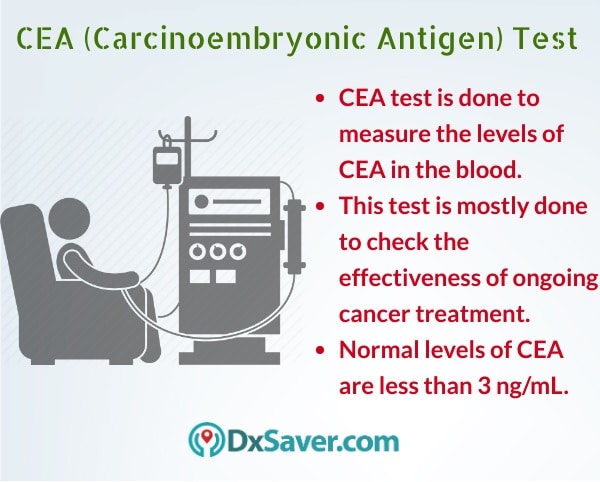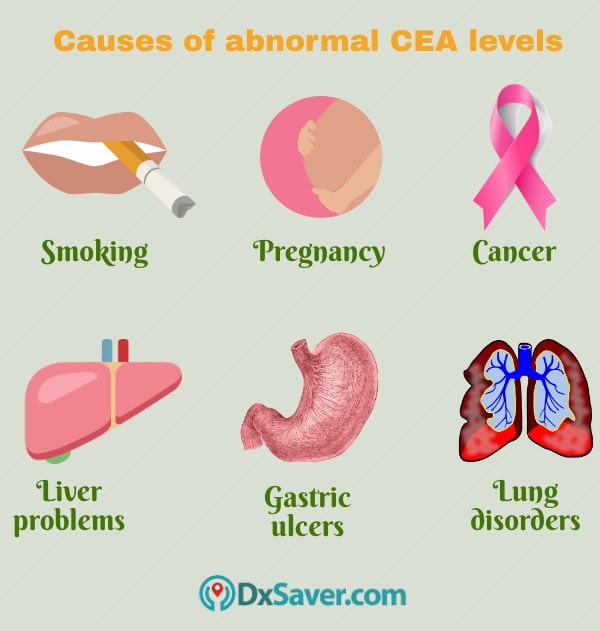
The CEA test is a simple blood test ordered by your physician to measure the amount of CEA in the blood. This test is mostly done to check the effectiveness of ongoing cancer treatment. According to the Centers for Disease Control and Prevention (CDC), more than 1.6 million people are diagnosed with cancer in the U.S. Cancer can be treated effectively only with a proper course of treatment. So we highly recommend people undergoing cancer treatment to get tested for CEA levels to ensure the effectiveness of the treatment.
The article below covers all the significant topics that are related to CEA blood test like the CEA test cost, normal CEA levels, test procedure, preparation, risks, when and how to get tested for a CEA blood test.
- CEA Test Cost.
- What is a CEA test?
- Why is a CEA blood test done?
- Normal levels of CEA.
- How is the CEA blood test performed?
- Is there any preparation required before the test?
- Are there any risks in the test?
- What does the CEA blood test results mean?
- Providers Locations.
For our readers, who are very much interested in knowing the CEA test cost beforehand, we would like to begin with that section.
How much does the CEA test cost?
CEA test costs $59 in the U.S. No prior appointment is required. Compare the price, order your test online and visit the nearest lab during lab business hours. Complete the procedure and get the results in your email in 2 to 3 business days. Doctor consultation is also available for further treatment or any kind of medical advice.
The following table shows the CEA test cost at one of our partner laboratories (CLIA – Certified) network located across the U.S.
Name of our Partner Labs | Book Online |
Personal Testing Lab
| Offer Price$59 Book Now |
CEA test cost with insurance
Most of the health insurance policies in the U.S. cover the cost of the CEA test. However, the coverage offered by private health insurance companies and national health insurance programs like Medicare and Medicaid varies widely. So we recommend you to check the specific coverage of your health insurance plan with the insurance company before getting tested for CEA levels.
Our CEA testing providers do not accept any kind of health insurance plan. But, if the insurance company accepts to reimburse you, they can provide you with an itemized receipt containing all the details like the name and code of the test, and CPT code that is necessary for insurance reimbursement purposes.
What is CEA?
CEA refers to the carcinoembryonic antigen. It is a type of protein present in the tissues of a fetus. When the baby is born and grown into a healthy adult, the CEA levels naturally degrades to a very low level. But time to time the cancer cells tend to rise the CEA levels.
CEA is a tumor marker. Tumor markers are nothing but the substances made by cancerous cells or normal cells in response to cancer in the body. So, the high level of CEA in the blood can indicate the presence of cancerous cells in the body.
Why is a CEA blood test done?
CEA blood test is done to measure the levels of CEA in the blood. Your physician will order a CEA test for the following reasons.
1. If you show symptoms that suggest you might have cancer. However, the CEA test is mostly not used as a screening test.
2. Sometimes, to diagnose a type of cancer that produces CEA such as
- Colorectal or colon cancer
- Medullary thyroid carcinoma
- Breast cancer
- Liver cancer
- Lung cancer
- Ovarian cancer
- Pancreatic cancer
- Prostate cancer
- Cancer of the gastrointestinal tract
3. If you have been diagnosed with cancer, to figure out the stage of cancer.
4. To check the effectiveness of chemotherapy, radiation, or surgery
5. To check the recurrence of cancer after treatment

Normal levels of CEA
Generally, most healthy people have very low CEA levels. The normal CEA levels in the blood are less than or equal to 3 ng/mL (nanograms per milliliter). In an adult, if the levels exceed beyond 3 ng/mL it is considered as high CEA levels and has a likelihood of cancer cells in the blood.
How is the CEA blood test performed?
The CEA test is a simple test that is done using a blood sample.
During this test, a lab technician or a phlebotomist will cleanse the area to be injected with an antiseptic liquid and wrap an elastic band around the upper arm to make the vein visible and pool with blood. He/she then injects a needle to draw a sample of blood and collects the sample in a test tube or a vial (a small glass container). After the blood is drawn, he/she will ask you to apply pressure on the injected area with a band-aid or a cotton ball to stop bleeding. The collected blood sample is then sent to the laboratory for further testing.
It takes less than 5 to 10 minutes to perform this test.
Is there any preparation required before the test?
For a CEA blood test, there is no special preparation required. But before the test, it is very important to inform your physician whether you are pregnant or a smoker or taking any medications or vitamin supplements as they may influence the CEA levels and result in an inaccurate diagnosis.
Are there any risks in the test?
There are no possible risks or complications in the CEA blood test. But sometimes after the blood sample is drawn, you might feel dizziness, slight pain, bruise, soreness, or redness in the puncture site for a very little period. If you have any abnormal bleeding in the injected area, inform your physician or phlebotomist immediately.
What does the CEA test results mean?
The test results are considered abnormal when the CEA levels are higher than 3 ng/mL. The abnormal levels of CEA can indicate the possibility of the following conditions
- Cancer
- Breast cysts
- Chronic obstructive pulmonary disease (a breathing disorder)
- Infection
- Ulcers
- Pancreatitis
- Cirrhosis
- Inflammatory bowel disease
If the CEA test levels are higher than 20 ng/mL in people diagnosed with cancer and undergone treatment, it strongly indicates that the treatment is ineffective and cancer has vigorously spread to other parts of the body.
If appropriate and necessary, your physician might also order other tests to rule out and confirm the diagnosis.

Providers Locations
The CEA blood test can be done in any of the following locations across the U.S. by visiting the nearest lab. To know the CEA test cost, refer to the first section of the article
- Alabama
- Arizona
- Arkansas
- California
- Colorado
- Connecticut
- Delaware
- Florida
- Hawaii
- Georgia
- Idaho
- Illinois
- Indiana
- Iowa
- Kansas
- Kentucky
- Louisiana
- Maine
- Michigan
- Minnesota
- Mississippi
- Missouri
- Montana
- Nebraska
- Nevada
- New Hampshire
- New Mexico
- North Carolina
- North Dakota
- Oklahoma
- Oregon
- Pennsylvania
- Puerto Rico
- South Carolina
- South Dakota
- Tennessee
- Texas
- Utah
- Vermont
- Virginia
- Washington
- West Virginia
- Wisconsin
- Wyoming
Frequently Asked Questions
Will insurance cover my testing cost?
No, insurance will not be covered in the billing. However, they will provide you a receipt for insurance reimbursement purposes.
How should I book my appointment?
You can choose the most suitable provider from above and make an appointment by following the instructions mentioned by them.
Can I cancel my lab test order?
Yes, you can cancel your lab test order anytime before your testing. A refund will be initiated after deducting the cancellation fee. However, cancellation is at the discretion of the provider.
Do the providers offer result interpretations?
Yes, a few providers may provide doctor consultation who will take you through the results and provide clarification if needed.
How do I receive my report?
To ensure your privacy, the test report will be mailed to you by the provider.
Other topics you may be interested in:-
- Cost of PSA Test for Prostate Cancer in the U.S.
- What STDs Cause Blood in Urine?
- What STDs cause Sore Throat?
- STD Testing Cost in the U.S.
- At home Chlamydia Test Cost in the U.S.
- Estrogen Test Cost in the U.S.
- Eye Chlamydia Symptoms
- How much does the Sickle Cell Testing Cost in the U.S?
- Cost of the Lipid Panel Test in the U.S.
- Can I Get an STD from a toilet seat?
- HCV, Hepatitis C Test Cost in the U.S.
- Cost of Stool Culture testing in the U.S.
- Ovulation Test Cost in the U.S.
- Importance of Prolactin Hormone & Fertility
- Renal Panel (Kidney Function Panel) Test Cost in the U.S.
- Oral STDs: Names, Symptoms, Treatment and Testing Cost
- Causes of Penile Rashes and Other STD Symptoms in Men
- HPV in Women: Symptoms, Genital Warts, Treatment and More
- What is D-Dimer Test? Know more on Normal Levels, Diagnosis & Treatment






